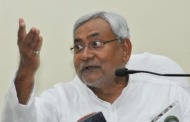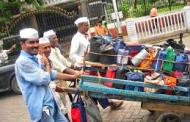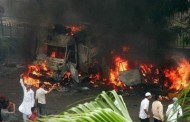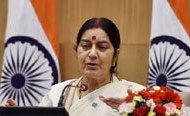Running with pride of being an Indian comes naturally to this Gorkha girl, Roshni Rai. With her project “Run with Roshni”, she wishes to bring her Nepali-speaking community, which has been facing racial discrimination and an identity crisis, to the Indian mainstream. A Mumbai resident for 10 years, Rai will be running at the Standard Chartered Mumbai Marathon in January with 10 of her community members from Darjeeling.
Coming from a small village called Pedong in Darjeeling, 34-year-old Rai has represented India at various national and international marathons and races. She claims to be the fastest of the three Indian women at the 2012 South African human race “Comrades Ultramarathon” of 89 km and takes pride in her nationality, but everything hasn’t been a smooth sailing for her as she struggled with identity crisis in her own country. “We are Nepali-speaking Gorkhas but we are Indian. Many people don’t realise that Nepali is a language listed in the Indian constitution and found on Indian currency notes,” says Rai, who began the project with the express purpose of being accepted as Indian.
Run with Roshni began in 2011 to support native Darjeeling athletes and bring them to the forefront. “Athletes in Darjeeling participate in every single race to support their own education and, with this project, I wish to bring empowerment and enlightenment to our community,” she says.
Rai began running at the age of 23 when she suffered a heartbreak. “I was heartbroken and bedridden for 15 days. I couldn’t eat or sleep, and felt utterly useless. One day, I just went out on a run and cried my heart out. I kept crying and running. At one point, the tears stopped but my feet didn’t. I felt so light and kept doing it regularly. That was in 2003 and in 2006, I saw the Mumbai marathon and tried to run it without any practice. I injured myself and felt I couldn’t run in future,” says Rai, who ran six half marathons in 2009.
Rai is a Powai resident and an advocate by profession. She completed her law degree from Mumbai university and started working at Colgate Palmolive, where she got to know the runners club and her coach Daniel Vaz, who taught her the systematic way of running a marathon. She took up Run with Roshni in 2011 as a part of a leadership course. Ever since she has been collecting second-hand shoes and funds through Facebook and other means to send them to promising athletes back home in Darjeeling. “Most of them come from a poor background and can’t afford train tickets sometimes. I know these runners and I am confident that they can run a full marathon under three hours without practice. We want to represent our country so that we get accepted as countrymen,” she stresses.
Rai says she is tired of explaining her nationality to everyone. “Even when I practise, exercise or run on the roads, I get called Chinese or chinki. The friendship treaty between Nepal and India further complicates our identity crisis and, for the same reason, we want a separate state of Gorkhaland. The Ghorkaland agitation of the1980s saw 1,500 deaths but nobody talks about it. I only want to spread awareness,” she says.
Rai, who has been honoured with the Kalimpong Ratna award back home, has taken a break from work and is focussing on her book that she wishes to publish next year. She wants to become a full-time social worker.
Rai believes that they can compete with Kenyans and Ethiopians as running is in their blood. “Walking 16 to 20 km everyday is normal for people in the hilly areas. I was inspired by author Brandon I Koerner’s piece on why Kenyans win all marathons and observed that we could challenge them too in the Olympics. There is a boy in our group who used to be a drug addict but became clean due to running. He says it gives him the same high. Running releases the happy hormone,” she says. [From DNA News]
The before and after pictures say it all. And now, exactly 10 years on, it is almost unimaginable that Aceh was left devastated by a massive tsunami, triggered by an undersea earthquake so powerful it made the earth itself wobble on its axis.
On the western tip of Indonesia, Aceh province was the closest landmass to the earthquake epicentre, and by far the worst affected. About 170,000 people died, hundreds of thousands more lost their houses and livelihood. Most man-made structures, some of them three miles inland from the 500-mile coastline, were completely destroyed.
The disaster triggered a massive influx of international aid, and a decade later, Aceh can say it has been successfully rebuilt. “On the ground, if you look around, things are really normal, much better than before,” says Kuntoro Mangkusubroto, who headed Aceh’s reconstruction agency.
Some 140,000 houses were rebuilt across the province, as well as clinics, schools and other buildings. A total of 3,500 roads were rebuilt. “I think it’s the only place in Indonesia where village roads are paved,” says Mr Mangkusubroto.
Banda Aceh, the province’s capital, is now a small pleasant city on the seaside. But most of its inhabitants today are survivors who lost relatives. Buildings might have been rebuilt, but the disaster still dominates the identity of the city and its people.
Across the city, tsunami landmarks have been preserved for remembrance. In Gampong Lampulo, a fishing boat stranded on top of crumbling houses stands out. The tsunami’s massive waves flung it here, nearly two miles from the sea.
Fauziah, 45, sells souvenirs to tourists who come see the “boat on the roof”. Her house used to be under the fishing boat, and she is one of 59 people who managed to climb on to it and survive the wav
After the earthquake, my son went to see what was going on,” she remembers. “He came back running and screaming ‘Go upstairs, Mum, upstairs’.” Fauziah took her five children to the second floor, but, “in seconds the water was everywhere.” Soon, they had water up to their chests. “We thought it was the end, that Judgement Day had arrived,” she says, as she shows how she carried her five-month old baby with outstretched arms to try to save her. “Then we heard people screaming that there was a boat stuck on the roof.
READ MORE: How the tsunami sparked a huge fertility boom
Where did all the toxic debris end up?
“My son managed to kick a sheet of metal from the ceiling, just enough for one person to get through. He climbed on to the roof, and then helped us out, and on to the boat.” For hours, they watched their city being destroyed. “The sea was everywhere, no building standing. The waves hitting houses sounded like bombs being dropped.”
Today, Fauziah sells dried fish that she prepares herself and displays in boxes decorated with photos of the boat.
While she feels grateful for the fact that the boat became a tourist attraction, allowing her to make a living, she admits to having mixed feelings. Fauziah’s five children survived, and the baby she held above her head is now a shy 10-year-old girl. But her husband, her mother and brothers and sisters all died in the tsunami.
“Sometimes I feel sad,” she says. “I see people over there having fun and laughing. As if this is a place for having fun.”
Elsewhere in the city, a 2,600-tonne cargo boat brought in by the waves was also left untouched. This boat hasn’t saved any lives; it razed an entire neighbourhood. “We suspect there are still lot of bodies under it,” says Herlina, 29, who works as a guide on this site.
Like most of those who work on tsunami-landmarks-turned-tourist attractions, she’s also a survivor of the tsunami. “At first, it was very hard to talk to people about what happened. But working here, I got used to it,” she says, adding that her job has actually helped her. “As time goes by, I feel like this is trauma therapy for me.”
As many as 1,000 people visit the cargo ship on weekdays, at least twice as many during weekends and holidays, and many locals in the area benefit from this unexpected boost in tourism. “It’s turned into a good thing after the bad thing,” Herlina believes.
The most noticeable tsunami landmark in town is the massive museum dedicated to the tsunami, built in the city centre during reconstruction. Visitors enter through a dark, cave-like tunnel, water running down the high walls to the sound of echoing, almost monastic, chants. In one narrow, high-ceilinged tower inside the museum, names of victims are displayed on the wall, and only receive light from a small, round window at the top.
Its director, Zuhardi Hatta, says the museum is essential “to remember the hundreds of thousands of people we lost.” But many have found its high cost hard to swallow – the local tourism department says 150 billion Indonesian Rupees (£7.7m) has already been spent on it. People also complain there is not much inside. Even Mr Mangkusubroto, whose reconstruction agency contributed to building the museum, is less than positive.
“I don’t regret that we built a tsunami museum. The structure is good and it’s a beautiful building. But you go inside, you see nothing. There is no soul in this museum,” he says. Azhari Aiyub, who runs a local cultural centre, calls the museum a waste of money, and says it’s “ridiculous.”
“I went there yesterday, I saw all these people taking pictures, smiling. This is not about sadness, this is entertainment,” he says.
But the local authorities are proud that the museum has been conceived to serve as an escape building in case of a new disaster alert. “It can resist 12 to 15m waves and hold around 3,000 people,” Mr Hatta says.
Authorities have made disaster prevention a priority. Other escape buildings have been built, and people have been educated on evacuation procedures.
The country’s meteorological agency monitors potential earthquakes and tsunamis, a warning alert system has been put in place, and signs indicating the route to the nearest escape-building have been placed across the city.
The disaster prevention system has also been criticised – the warning sirens failed to ring during an earthquake in 2012 – but locals say they’re now prepared.
Rusmaizar, a 48 year-old fisherman living near the small port of Deah Glumpang in Banda Aceh, says “everyone ran straight to the escape building” following the 2012 earthquake. In case of a new disaster, “people will know what to do,” he says.
Patna: Taking strong exception to selection of non-tribal Raghubar Das as the new Jharkhand CM, senior JD(U) leader Nitish Kumar on Friday slammed BJP for breaking the tradition of a tribal heading the government in neighbouring state since its inception in 2000.
“It has been a tradition that a tribal has headed all governments so far in Jharkhand since its inception in 2000,” Kumar said.
By making a non-tribal as the next Jharkhand chief minister, the BJP has not only broken a long standing tradition but has also sent out a message that it has no faith in the tribal people of that state, he said.
“Jharkhand was created to cater to the aspirations of the tribal people and the sentiment was reflected in the fact that the chief minister’s post had gone to tribal population as a matter of their right so far,” Kumar said.
Claiming that the tribal population of Jharkhand may feel aggrieved and uncomfortable with a non-tribal leader leading the state government, the senior leader charged the BJP with laying foundation of ‘disaffection’ between the tribal and non-tribals in the neighbouring state, which he alleged, fitted with the divisive politics being pursued by the saffron party.
PTI
A wave of joy spread among the dabbawallahs in Mumbai, as Prime Minister Narendra Modi on Thursday nominated the world-famous lot among nine people and organisations to take forward the Swachh Bharat Abhiyaan.
As soon as the news broke on television and word spread, the 5,000-odd dabbawallas, who deliver around 2,00,000 dabbas across Mumbai daily, began to celebrate. “By nominating us, the Prime Minister has gone beyond celebrities and business tycoons and encouraged hard-working ‘kaamgar’ (workers) like us. We are very thankful to him. It is a special moment for us,” said Subhash Gangaram Talekar, spokesperson of the Mumbai Dabey Wahatuk Mandal.
At around 11.15am, the time when these ever-busy men who ferry thousands of tiffin boxes across the city take a few minutes’ break, the dabbawallas celebrated their nomination by distributing laddoos. “It is a matter of pride for us. We are also aware of the fact that we now have a great responsibility towards the nation,” said Talekar.
Well known for their efficient and nearly error-free business model for 124 years, the dabbawallas said they won’t waste a moment and will carry out the drive as early as Friday. Again at 11.15am, hundreds of them will wield brooms and clean up the area around Lower Parel station.
“Our brooms and garbage bags will be ready at the station when we reach. We plan to complete our task in 20 minutes, as we cannot delay in supplying the dabbas,” said Bhasaheb Karvande, the association’s chairman.
Talekar said their contribution to the national cleanliness movement, launched by Modi on October 2, won’t end with the drive. “We will carry the message to all our clients every day. We all live in chawls and small houses, and have always seen our areas full of filth. We know that cleaning up the country is no mean task; it is a long and slow process,” he said.
Bobbi Jene (2017)
| Release | : | 2017-09-22 |
| Country | : | United States of America,Denmark,Sweden,Israel |
| Language | : | English |
| Runtime | : | 95 |
| Genre | : | Documentary |
Synopsis
Watch Bobbi Jene Full Movie Online Free. Movie ‘Bobbi Jene’ was released in 2017-09-22 in genre Documentary.
A love story, portraying the dilemmas and inevitable consequences of ambition. It is a film about a woman’s fight for independence, a woman trying to succeed with her own art in the extremely competitive world of dance.
Streaming Movie Bobbi Jene
(2017) Online
Incoming search term :
Watch Bobbi Jene Full Movie Online Free Streaming In HD Quality, watch full Bobbi Jene movie, Watch Bobbi Jene 2017
Online Free Viooz, Watch Bobbi Jene 2017 Online Free, Watch Bobbi Jene 2017 Online Putlocker, film Bobbi Jene
online, Streaming Bobbi Jene 2017 For Free Online, streaming movie Bobbi Jene 2017, Bobbi Jene film trailer,
Bobbi Jene movie trailer, live streaming film Bobbi Jene 2017, Streaming Bobbi Jene 2017 Online Free Megashare,
movie Bobbi Jene streaming, Watch Bobbi Jene 2017 For Free online, film Bobbi Jene 2017 online streaming,
download Bobbi Jene 2017 movie now, movie Bobbi Jene 2017 download, watch full movie Bobbi Jene 2017, trailer
film Bobbi Jene 2017, Watch Bobbi Jene 2017 Online 123movies, Watch Bobbi Jene 2017 Online Free 123movie, Watch
Bobbi Jene 2017 Online Free Putlocker, movie Bobbi Jene 2017 trailer, Watch Bobbi Jene 2017 Online Free
netflix, watch Bobbi Jene film online now, Bobbi Jene 2017 movie streaming, Bobbi Jene 2017 Watch Online, Watch
Bobbi Jene 2017 Online 123movie, download movie Bobbi Jene, Watch Bobbi Jene 2017 Online Free megashare, watch
Bobbi Jene movie now, Watch Bobbi Jene 2017 Online Free hulu, Watch Bobbi Jene 2017 Online Viooz, live streaming
movie Bobbi Jene 2017, Bobbi Jene live streaming film online, movie Bobbi Jene 2017, Watch Bobbi Jene 2017 Online
Megashare.
This is the time of the year when millions across the globe pray for peace on earth. And no, this is not being said ironically. Surely, as the year winds down to a close, humanity can get together to celebrate the idea of peace, of hope, of compassion, no matter what one’s religious affiliations might be?
But this seems to be a futile wish.
Even as people prepare to celebrate, in various ways, the end of the year, a bloodbath once more engulfs this land. In Sonitpur and Kokrajhar districts of Assam, suspected National Democratic Front of Boroland(S) killed innocent villagers, mostly Adivasis, when they opened fire on Tuesday.
Among the dead were women and young children.
And then the terror, and inevitably, the retaliation. The newspapers have pictures of people fleeing their homes, their possessions in little bundles on their heads. There is grief in their eyes, and horror. Frail men, young and old, arm themselves with nothing more lethal than fragile, primitive bows and arrows, against the modern guns used against them.
The death toll is 72 and rising, and retaliatory attacks are taking place, as expected. In these, and in police firing, seven more have been killed, bringing the total so far to 79.
And so it goes, endlessly. Horror piled on horror.
Around the year, across the globe, there have been numerous deaths at the hands of terrorists. These come to us via the media. Some get worldwide coverage, as well they should. Earlier this month, sending chills up the spines of all were the pictures of the attack on schoolchildren in Peshawar, Pakistan. That was perhaps a new nadir in human depravity, though who knows, even that point might soon be breached.
But some others terror attacks, such as the ones in Kokrajhar and Sonitpur, have hardly been noticed by mainstream media. Even though these assaults are equally horrifying, and deserving of condemnation in the strongest terms. It is not that media coverage will alleviate the sufferings of the survivors. But there is the hope that perhaps, if the rest of the world comes to know of it, there will be awareness of what is going on. And through awareness, perhaps, there will come condemnation, and ultimately, a refusal to tolerate this kind of terrorist attack by the larger communities of the world, in future.
And yes, it is a sorry thing when we weigh “gravity” and “importance” of the horrors around us, to allocate space in our papers and our electronic media. A violent death by a terrorist attack brings trauma and untold grief and misery in its wake, crippling the survivors and scarring them for life. But there is, today, a kind of “terror fatigue” which ensures that only the most gut-wrenching acts of terrorisms make it to the consciousness of the world. The other, numerous deaths by terrorist acts remain in the local media. There seems to be a hierarchy in this matter. This is a very sad, but very true fact of life.
This is a wretched commentary indeed on the state of the world today. Has civilisation reached such a low point that horrific acts must now jostle with each other for media space, each one more terrifying than the last?
We see that body counts matter, even in the space allocated to the news of deaths by terror attacks.
We see that location matters. A large number of deaths in a remote area, considered peripheral by the “mainstream”, merits less space than fewer numbers in a place deemed to be more “central”, therefore more “important”.
We see also that economic status matters. The rich, and the middle class get more media space if they become the victims of these attacks. As for the poor – well, even as pictures of lines of them fleeing their burning homes stream into our drawing rooms, one face merges into the next, one scream of terror begins to sound very much like another.
And that, too, is another aspect of the horrors of the times that we live in.
When last seen in public some 25 years ago, Dawood Ibrahim was a chubby man with oversized sunglasses and a droopy mustache. His fondness for betting on cricket matches and keeping company with Indian movie stars has attracted police investigations and tabloid headlines.
Ibrahim is also one of India’s most-wanted terrorists. He’s linked to bombings that killed hundreds of innocent men and women in his native country. India and the U.S. accuse him of financing Pakistani militants who killed hundreds more, as well as brokering a deal with al-Qaeda to allow the group access to his smuggling routes.
And all available evidence culled from accounts on the ground in India and Pakistan, buttressed by reports from the U.S. and United Nations, point to one conclusion: Ibrahim is living in Pakistan.
Just as Osama bin Laden’s death at a house down the road from the Pakistan Military Academy set off fierce debate about the nation’s commitment to fighting terrorism, Ibrahim has become a symbol of why Pakistan’s neighbors often don’t take its public statements about uprooting militants seriously.
The cost of that reluctance was underlined in blood last week when Pakistani Taliban militants murdered 152 people, including 134 children, in the nation’s northwest city of Peshawar. In the aftermath of that slaughter, Prime Minister Nawaz Sharif vowed to wipe out every last terrorist from Pakistani soil.
A traffic police officer stands and directs traffic through the streets of Karachi, Pakistan.
There are no indications that Ibrahim, thought by police to be 58 years old, had anything to do with the carnage in Peshawar. In fact, officials in Islamabad insist, as they did with bin Laden, that he isn’t in their country at all.
‘No Information’
“Pakistan has no information about his whereabouts,” Tasnim Aslam Khan, a foreign ministry spokeswoman in the capital, said by phone on Dec. 20. Switching between Urdu and the lightly-accented, crisp English of her country’s elite, she continued: “He’s an Indian national. Sometimes we hear he’s in Bangkok, and sometimes elsewhere.” Maj. General Asim Bajwa, chief spokesman for Pakistan’s military, didn’t respond to text messages or an e-mail seeking comment.
Ibrahim’s story personifies the violent and, often, shadowy nature of relations between India and Pakistan, which together hold about a fifth of the world’s people. The two nations were cleaved from one another by physical partition when British colonial rule ended in 1947, leaving hundreds of thousands dead just eight years before Ibrahim’s birth. The region now contains a tempest of corrupt officials, religious zealots and competing business interests that can be unpredictable — men who pull triggers for you today can turn their guns back on you tomorrow.
Pedestrians cross a road in the Dharavi slum area of Mumbai, India.
Simply ‘Dawood’
The son of a Mumbai police constable, Ibrahim worked his way up from smalltime street thug to the city’s most powerful gang leader. Police in Mumbai say that he ran a protection and smuggling racket before moving to Dubai in the 1980s. He is known to readers of Indian newspapers simply as “Dawood,” a main inspiration for the Mafioso archetype in Bollywood films.
A former aide of Ibrahim, wearing a fat diamond and ruby ring on his finger, said his old boss had a taste for expensive cigarettes, nice cars and Italian suits. These days, he said, Ibrahim can’t travel as far as he used to.
Photographs of Ibrahim, whose full name is Dawood Ibrahim Kaskar, are easily accessible on the Internet. Despite facing criminal charges from India, standing accused by the U.S. and the UN of terrorist activities, and being listed by Interpol, Ibrahim remains free — and thought to be not far from his hometown.
Karachi Homes
The alleged mass murderer has long done business in Karachi, a Pakistani megacity that like Mumbai sits on the Arabian Sea. The twin metropolises are some 540 miles from one another on the same coastline, roughly the distance of a quick flight from New York to Charlotte, North Carolina. Ibrahim’s presence there, complete with stories of large homes and lavish parties, was confirmed by Bloomberg News in conversations this year with a half dozen past associates and witnesses in Karachi and Mumbai, as well as Indian officials. Many asked not to be identified due to fears about their personal safety.
For Indians, the suggestion that they’re still in touch with a man seen by law enforcement as something of a Judas figure — the son of a cop who betrayed his own country — could bring trouble. The same is true in Pakistan, where confirming his presence contradicts the official line and might cause an unwelcome visit from intelligence agencies. And then there’s always the risk of offending the man himself.
U.S. Sanctions
As India and the U.S. made political overtures this past year to mend a relationship that had drifted, part of the rapprochement included renewed efforts to squeeze Ibrahim.
Indian Prime Minister Narendra Modi and U.S. President Barack Obama, the leaders of the world’s two largest democracies, issued a statement after a September summit in Washington, D.C. that listed Ibrahim’s organization, known as D Company, among those for which they would seek to jointly “disrupt all financial and tactical support.”
D Company was named a “significant foreign narcotics trafficker” in 2006 under a U.S. anti-narcotics kingpin law. A 2010 Congressional Research Service report said that D Company’s business model includes smuggling humans and money, and selling drugs — pointing to it as “an example of the criminal-terrorism ‘fusion’ model.”
Indian officials accuse Ibrahim of helping mastermind a dozen bombings and grenade attacks that ripped through Mumbai in March 1993, killing 257 people and wounding 713 in one of the deadliest terrorist attacks in the nation’s history.
Pakistani Passports
After that onslaught, according to U.S. Treasury and UN reports, Ibrahim doled out cash to Lashkar-e-Taiba. The outlawed militant organization is based in Pakistan and opposes India’s presence in Kashmir, a region divided between India and Pakistan and claimed by both. A senior Lashkar-e-Taiba member used money from Ibrahim to “facilitate the July 2006 train bombing in Mumbai,” the UN said in a 2009 report. Those seven blasts left 187 dead and 829 injured. The group also stands accused of carrying out a 2008 commando-style assault on Mumbai that killed 174 people.
The U.S. Treasury has published passport numbers for Ibrahim, including two issued by Pakistan’s government. The U.S. and UN listed addresses in Pakistan that correspond to a series of villas in Karachi and Islamabad obscured by high walls. A street near one was blocked by guards earlier this year. Two trucks of gunmen sat close to another. Business cards left on outer gates didn’t result in calls back.
Policeman’s Son
Retired Lt. General Hamid Gul, who headed Pakistan’s Inter-Services Intelligence agency for a period in the 1980s and said that he became “very popular with the jihadis,” claimed Ibrahim was “probably not involved” in the 1993 Mumbai bombings. He said there was no connection between the agency, known as ISI, and Ibrahim.
As for Ibrahim’s whereabouts, Gul, dressed in a blue cardigan sweater and gray blazer, shrugged. “I don’t know about him,” he said in a February meeting in Islamabad. “They say that he’s in Karachi.”
At Ibrahim’s old south Mumbai neighborhood of Dongri, cramped restaurants sell bone marrow soup and mosques sit among shops selling Korans and bedazzled iPhone covers. One of his brothers, Iqbal Kaskar, still lives up a dim flight of stairs nearby, a location confirmed by a family lawyer. He didn’t respond to requests for comment.
As Ibrahim’s gang rose first in Muslim quarters and then across the city, it maintained cordial ties with the police, said Shamim Hava, a mining businessman involved in regional politics who grew up in the area. “Because his father was a policeman,” he said, “they always had a soft spot for him.”
Spy Agency
Shamsher Khan Pathan, a cop who worked Ibrahim’s neighborhood in the 1980s and retired as assistant commissioner of police for Mumbai in 2012, gave a different reason for why men in uniform left Ibrahim and his men alone: “Money.”
Ibrahim first established a relationship with Pakistan’s ISI spy agency while building his smuggling operations for consumer goods, then gold and finally drugs, according to Indian security officials.
ISI operates as an empire unto itself in Pakistan, beyond the control of any civilian authority. It smoothed the way for Ibrahim to make illegal shipments in the region, said Gopal K. Pillai, who helped oversee security and intelligence agencies as India’s home secretary from 2009 to 2011.
That bond grew tighter as Ibrahim spent time in Dubai, where criminals, businessmen and spies from across the region had space to mix in a murky underworld, Pillai said in a meeting in Delhi late last year.
“Everybody plays one way, two ways, three ways — and at the end you don’t know what really is the truth,” Pillai said. “But it’s a game which everybody plays. So, he got into that.”
Mumbai Bombings
In December of 1992, a crowd of Hindu nationalists tore down a mosque in northern India. Riots followed between rampaging mobs of Hindus and Muslims that month and the next. Hundreds of people were killed in Mumbai, the majority of them Muslim. Ibrahim was watching.
“He was angry and he was frustrated and he wanted to do something,” said Rakesh Maria, Mumbai’s police commissioner, who has worked in counter-terrorism and made taking down Ibrahim a life’s ambition. “This is where these people, ISI, came into the picture.”
No one interviewed about Ibrahim described him as being a religious ideologue. They attributed his role in the 1993 bombings in varying degrees to a desire for revenge after the bloodshed in Mumbai and the ISI sensing an opportunity to exploit him to strike an old foe. Current and former Indian officials presented Ibrahim’s relationship with the ISI as one of mutual convenience: The spy agency gave safe haven for him personally as well as his broader criminal network, with Ibrahim in return offering financial backing and logistical support to ISI-backed militant groups.
Guns, Grenades
Confessions showed that those picked up after the attacks were tutored in bomb-making and “handling of sophisticated automatic weapons like AK-56 Rifles and handling of hand grenades in Pakistan,” the Supreme Court of India wrote in a 2013 judgment reviewing death sentences for men involved in the bombings. The training circuit, the court said, was “organized and methodically carried out by Dawood Ibrahim” and others.
U.S. officials have kept tabs on Ibrahim over the years, according to diplomatic cables published by WikiLeaks in 2010. One document details a 2004 meeting with an anti-money laundering official in the United Arab Emirates to discuss Ibrahim; another notes allegations that same year of his links with an Islamist group in Indonesia; and a 2009 cable mentions his alleged links to drug trafficking in Mozambique.
‘Global Terrorist’
When answering questions about Ibrahim, U.S. officials are cautious. The U.S. gave Pakistan about $26 billion in overt aid and military reimbursements between 2001 and 2013 even as American drones killed suspected terrorists in the country.
Although the U.S. Treasury named Ibrahim a “Specially Designated Global Terrorist” in 2003 and listed known addresses for him in Karachi, American officials never publicly demanded that Pakistan hand him over.
Asked about Ibrahim earlier this year, the U.S. embassy in Islamabad sent a statement grouping him with Hafiz Saeed, a Pakistan resident who helped create Lashkar-e-Taiba, the militant outfit that Ibrahim allegedly funded. “We encourage the Government of Pakistan to enforce the sanctions against these individuals,” said the statement. The embassy said in October it had nothing to add.
Legitimate Businessman
Last month, Indian Home Minister Rajnath Singh told a conference in New Delhi that Ibrahim had been moved to Pakistan’s border region with Afghanistan after increased diplomatic pressure to have him extradited.
While Ibrahim’s exact address in Pakistan isn’t known, his past wheeling-and-dealing in Karachi left a trail.
Some around the world consider Ibrahim a terrorist, but in Pakistan he’s a legitimate businessman, said a top real estate broker in Karachi, between sips of tea in the lobby of the city’s Marriott.
Ibrahim invests in residential projects and undeveloped plots of land, said the broker, who wore sunglasses indoors and added that he’s advised Ibrahim on past ventures. The money is routed through proxies and the transactions are perfectly legal, he said, adding that Ibrahim hasn’t done anything wrong in Pakistan.
In 2005, Ibrahim’s daughter married the son of famous retired Pakistani cricket player Javed Miandad. News of a ceremony held by Ibrahim’s family in Dubai was splashed across headlines in India. The patriarch apparently didn’t show up.
Seaside Wedding
Miandad’s family later held a quieter function at a hotel in Karachi with a guest list that included Imran Khan, a former captain of Pakistan’s national cricket team and now a top opposition politician.
“Believe me, I never saw Dawood Ibrahim there,” Khan said in an interview. Miandad declined to discuss Ibrahim.
As recently as 2011, Ibrahim hosted a wedding event in Karachi for his son, according to one of the city’s wealthiest businessmen, who attended. The proud father and accused terrorist greeted guests at the wedding hall, decorated by billowing white tent roofs near the Arabian Sea. The site the businessmen named isn’t far from a McDonald’s and a beach-side shopping mall in Pakistan’s financial capital.
Although Ibrahim couldn’t arrange the family event in his hometown of Mumbai, there, under the skies of Karachi, he was safe. For Pakistan’s neighbors, that’s the problem.
External Affairs Minister Sushma Swaraj on Thursday said that religious conversions in the country will continue till a central law against the practice comes into force.
Such a law can come into existence if all political parties agree to it, the Union Cabinet minister said. She was responding to a question on whether events like Ghar Vapasi (reconversion ceremonies organized by right-win g organizations across the country) were proving a hurdle in the Narendra Modi government’s development and good governance agenda.
Defending anti-conversion laws in BJP-ruled Gujarat and Madhya Pradesh, the Lok Sabha member from Vidisha insisted that they did not ban voluntary conversions.
Mumbai: A civil suit has been filed in a Pune court against Akhil Bhartiya Hindu Mahasabha seeking a ban on its forthcoming film ‘Desh Bhakt Nathuram Godse’, slated for release on January 30.
The suit filed by activist Hemant Patil alleges that Mahasabha general secretary Munna Kumar Sharma had said in a section of media that “the film would show that Nathuram Godse, the assassin of Mahatma Gandhi, was a patriot while Gandhi was anti-Hindu”.
Civil Judge S S Nair has placed the suit for hearing tomorrow, said advocate Wajid Khan, the petitioner’s lawyer.
According to the suit, the film was being released on the same day when Godse had gunned down Mahatma Gandhi in 1948. “As the film has the potential to incite people on communal lines”, the petition has prayed for a ban on its release.
The suit’s main prayer is to stop the release of the film until the producer satisfies the court that it would not in any way flare up communal issues or cause disharmony among people.
A founder of the low-cost Indian airline SpiceJet has asked the government for more time to financially resuscitate the struggling airline. SpiceJet, India’s fourth-largest carrier, has been in a severe financial mess for most of the year. Earlier this month, thousands of SpiceJet passengers were stranded when unpaid suppliers refused to provide fuel, forcing it to cancel over 1,500 flights in the span of a week. Flights resumed only after the airline started the fuel in cash.
Ajai Singh who owns nearly 5% in the troubled airline is attempting a rescue and is reportedly in discussions with a few U.S.-based private equity funds. SpiceJet’s majority owner is media billionaire Kalanithi Maran (#38 on Forbes’ list of Indian rich) of the Sun Group who belongs to a prominent political family in southern India. Maran has refused to extend a helping hand but new reports indicate that Singh is inclined to buy his stake.
Meanwhile, amid falling fuel prices and a generally upbeat economic scenario, the Tata Group- Singapore Airlines joint venture, a premium full-service airline called Vistara, is set to launch on January 9. In ads, the airline promised personalized touches and seamless service.
Inventively, the airline is offering over half-a-dozen seat categories including business flexi, premium economy and supersaver economy.
But SpiceJet owes hundreds of millions of dollars in fuel dues, airport fees, taxes and salaries and it seemed imminent to become the second Indian carrier, after Kingfisher Airlines, to crash land within the span of two years.
No domestic investor or global airline has shown interest in bailing out SpiceJet. But the national carrier Air India is staying airborne thanks to government largesse in the form of billions of taxpayer dollars.
All but one Indian carrier, Indigo, are making losses as high airline fuel costs, steep operating costs and frequent fare wars have kept them in the red in an extremely competitive market. If SpiceJet is unable to revive, it will mean a setback for India’s airline industry. It will make the market a virtual monopoly of Indigo as competitors are too new or too small.





![Online [Free Watch] Full Movie Bobbi Jene (2017)](http://www.realnewsofindia.com/wp-content/uploads/2014/12/Gujarat-cop-shakes-a-leg-190x122.jpg)











Recent Comments